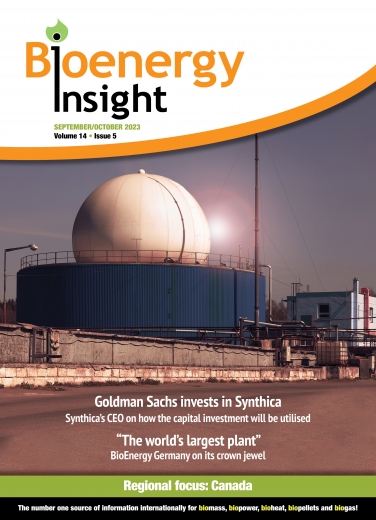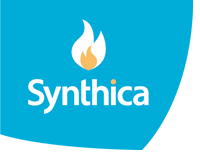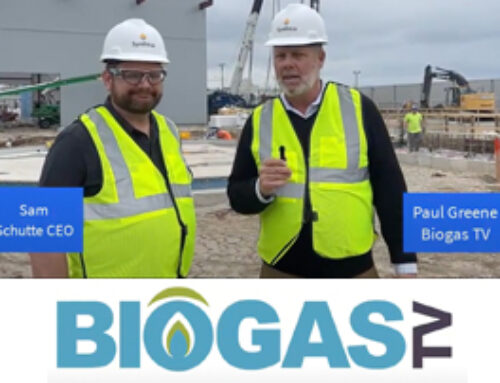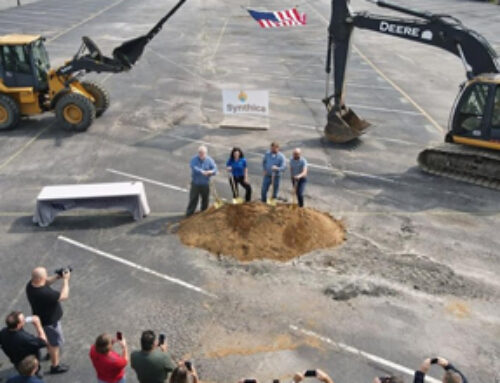Bioenergy Insight
October 2023 Cover Story
Sam Schutte, CEO of Synthica Energy, tells Bioenergy Insight how capital investment from Goldman Sachs will support the company’s long-term plans.
 Synthica Energy is an energy transition platform aimed to design, build, own, and operate largescale, contracted anaerobic digestion (AD) facilities to convert pre-consumer organic waste into renewable natural gas (RNG). The company aims to provide industrial manufacturers with a greener outlet for their organic waste, and to provide North American utilities with reliable access to RNG.
Synthica Energy is an energy transition platform aimed to design, build, own, and operate largescale, contracted anaerobic digestion (AD) facilities to convert pre-consumer organic waste into renewable natural gas (RNG). The company aims to provide industrial manufacturers with a greener outlet for their organic waste, and to provide North American utilities with reliable access to RNG.
“Distinct from many existing RNG developers, we focus on processing pre-consumer organic waste, such as expired grocery products, spent brewer’s yeast, and other byproducts of food manufacturing,” Schutte told Bioenergy Insight. “We also use ‘urban-friendly digestion’, incorporating multiple layers of odour control technology to minimise local impact. As a result, we expect our facilities to seamlessly coexist in communities producing high amounts of organic waste.”
Goldman Sachs investment
The company hit the headlines in a big way, following an announcement that it had closed on a “large equity investment” from the Infrastructure Business within Goldman Sachs Asset Management (GSAM).
“With this investment, we are aiming to take waste out of a one-way system and recycle it to generate renewable energy,” said Cedric Lucas, a managing director in the Infrastructure Business within GSAM. “Similar to our Verdalia investment in Europe focused on biomethane, we believe this sustainable process can provide dual benefits, helping businesses and municipalities beneficially reuse their organic waste and supplying the country’s utilities with RNG, critical for reducing their carbon footprints. We are thrilled about the opportunity to partner with Sam [Schutte] and Grant [Gibson, Synthica co-founder] and leverage the capabilities and relationships of our firm to bring sustainable infrastructure solutions to cities across the US.”
Financial terms of the deal were not disclosed, but Bioenergy Insight asked Schutte how the equity investment will support Synthica’s work, and how it will be deployed.
“The investment from the Infrastructure Business within Goldman Sachs Asset Management will enable us to accelerate our project development pipeline, enhance our circular solutions for customers, and supply RNG to meet the growing market demand,” he said.
Synthica’s flagship facility in Cincinnati broke ground in July and will begin operations soon. The company has five additional facilities in its pipeline that are in the final stages of permitting and approval, and more that are in preliminary planning stages. The timeline to site and develop a facility depends on many factors, but generally the process takes somewhere between 15 and 18 months. In the near term, the company plans to move forward with projects in Ohio, Texas, Georgia, Kentucky and Louisiana, said Schutte. In the longer term, the company is looking to develop sites in Florida, Illinois, Missouri, New York and Pennsylvania.
Business model and process
Synthica’s business model focuses on processing pre-consumer organic waste. In practice, this means that the organisation provides circular waste management solutions at facilities that are close to metro areas — large producers of pre-consumer organic waste. The business enters into contracts to accept organic waste from major food, beverage and industrial manufacturers. It utilizes AD to convert this organic waste into RNG, which can then be sold under offtake contracts with gas utilities, energy majors and industrial purchasers.
“This waste would otherwise be disposed of in a landfill or other unsustainable outlets and contribute to greenhouse gas emissions,” said Schutte.
In terms of the process itself, Schutte observed that AD is a naturally occurring process through which microorganisms break down biodegradable material. When organic materials are left to decompose in landfills, they emit greenhouse gases that contribute to climate change.
“Our process captures this methane before it is emitted and refines it into RNG, which can be used as a ‘drop-in’ fuel in place of fossil fuels in cars, stoves, hot water heaters, and many other applications,” he added.
Synthica focuses on pre-consumer food and beverage waste and organic manufacturing byproducts because companies that produce this waste have few environmentally friendly options to dispose of it, according to Schutte.
“Our goal is to provide a more efficient, greener solution for companies to dispose of waste in a way that protects the environment and generates fuel that we can use to power homes and businesses,” he said.
Another innovation Synthica is incorporating at its facilities is what it terms “urban-friendly digesters”. Its digesters are completely sealed vessels, and the company fills them in enclosed staging areas. On top of these precautions, it uses negative air pressure fans to push air through a bio filter that traps odours, Schutte explained.
“All of these odour control technologies enable our facilities to seamlessly coexist in urban communities producing high amounts of pre-consumer organic waste,” he said.
Effectiveness and challenges
When Bioenergy Insight asked how this model is more effective than utilizing post-consumer organic waste, Schutte explained that pre-consumer waste streams enable greater efficiency and consistency in the production of RNG. Post-consumer waste can vary in supply and contamination levels.
“Because we prioritise urban-friendly digestion, we are also able to minimize trucking by locating closer to the industrial facilities that provide the organic waste we process,” he added. “Whereas most RNG developers require materials to be trucked three-to-four hours to their facilities, we plan to locate our facilities much closer to our customers.”
The most common challenge Synthica faces with pre-consumer organic waste is siting facilities in locations that comply with local zoning regulations and are close enough to the major sources of pre-consumer organic waste the company uses to generate RNG.
“Fortunately, most cities understand the value of providing an efficient, clean way to keep pre-consumer organic waste out of landfills and use it to generate renewable energy and are willing to work with us to find a suitable location,” said Schutte. “Our commitment to urban-friendly digestion that uses the latest technology to avoid odours and minimise our local impact also makes it easier to find suitable locations.”
For the rest of this year, Synthica is focused on using the infusion of capital from GSAM in the most effective way to position the company for long-term success.
“We will be building out our Cincinnati, OH facility and also expect to take significant steps forward in Texas and other targeted markets before the end of the year,” concluded Schutte.






